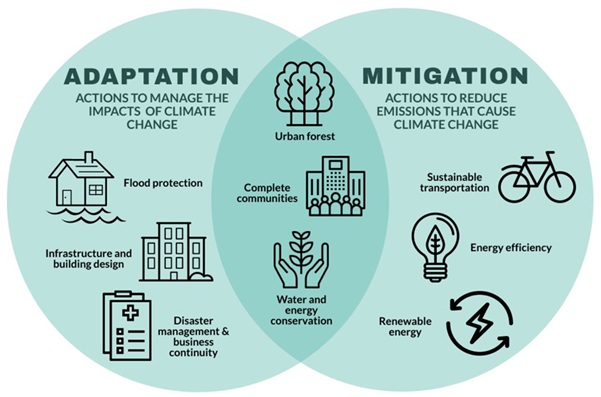Climate change has become one of the most urgent global crises, threatening both humanity and ecosystems. Rising global temperatures, extreme weather events, sea-level rise, and biodiversity loss are clear indicators of this challenge. Its impacts extend beyond the environment to social and economic structures. To address this crisis, mitigation and adaptation are two key strategies that need to be implemented with effective financial support, global cooperation, and technological innovation.

Mitigation
Objective of Mitigation
The goal of mitigation is to reduce greenhouse gas (GHG) emissions and limit global temperature rise.
Global Targets:
- Paris Agreement 2015: Limit the increase in global average temperature to well below 2°C above pre-industrial levels and pursue efforts to limit it to 1.5°C.
- Emission Reduction Goals: Reduce emissions by 42% by 2030 and 57% by 2035 compared to 2019 levels (Emission Gap Report, 2024).
India and Global Perspective
India:
- 3rd largest total GHG emitter (UNEP, 2024)
- Per capita emissions account for 4% of global emissions (Economic Survey, 2023-24)
Global Level:
Global GHG emissions reached a record level in 2023, increasing by 1.3% over 2022 (Emission Gap Report, 2024)
Challenges
- Emission Gap: Current national and international policies are insufficient to meet Paris Agreement goals.
- Lack of International Cooperation: For example, the U.S. withdrawal from global agreements.
- Inequality in Emissions: Six countries account for 63% of global emissions.
- Technical Challenges: Emission reduction in "hard-to-abate sectors" like aviation, shipping, and cement.
- Rising Energy Demand: AI, data centers, and digital technologies are increasing energy consumption.
Global and India’s Initiatives
- Global Initiatives:
- Global Methane Pledge
- Powering Past Coal Alliance
- Just Energy Transition Partnerships (JETPs)
- Mission Innovation
- India’s Initiatives:
- Panchamrit Targets (COP26): Net-zero by 2070
- Lifestyle for Environment (LIFE) initiative
- National Action Plan on Climate Change (NAPCC)
- Rapid renewable energy deployment and green bonds issuance
Technological Measures and Research
- Low-carbon technologies in hard-to-abate sectors
- Carbon Capture and Storage (CCS) research and investment
- Scaling up renewable energy: solar, wind, biomass
- Implementing energy efficiency measures and smart grids
Adaptation
Importance of Adaptation
Adaptation aims to reduce the impacts that occur despite mitigation efforts, e.g.:
- Damage to coastal cities and heritage sites due to rising sea levels
- Protecting rural and vulnerable communities from floods, droughts, and cyclones
India’s Adaptation Efforts
- National Adaptation Fund on Climate Change (NAFCC, 2015)
- Local adaptation projects in agriculture, water management, and forestry
- Climate-resilient urban planning and climate budgets
Climate Finance
- Global Trends
- Global climate finance increased from $674 billion in 2018 to $1.46 trillion in 2021-22
- 54% of climate finance comes from private sources
- Compound annual growth rate (CAGR) 2018–2022: 20%
Financial Needs for India
- Energy transition until 2047: ~$250 billion/year
- Achieving updated 2030 NDC targets: ~$2.5 trillion
- Achieving net-zero by 2070: ~$10 trillion
Key Challenges
- Developed countries received 45% of climate finance, LDCs only 3%
- 90% of finance goes to mitigation, only 10% to adaptation
- Most investments are debt or equity-based, increasing the financial burden on developing countries
Solutions and Measures
- Global Level: Loss and Damage Fund (LDF), Green Climate Fund (GCF), Special Climate Change Fund (SCCF), Adaptation Fund
- India: NAFCC, green bonds, Sustainable Finance Group (RBI)
- Innovative instruments: debt-for-climate swaps, private capital mobilization, carbon markets
Loss and Damage Fund (LDF)
Introduction
- Agreed at COP27 and operational from COP28
- Outcome of Warsaw International Mechanism (WIM)
- Purpose: provide financial support to countries most affected despite mitigation and adaptation efforts
Features
- Total financial commitment: over $730 million
- Targets countries and communities most vulnerable to climate change
- Example: Rising sea levels threatening heritage sites and small island developing states (SIDS)
Challenges
- Lack of agreement on L&D activity classification
- Limited data and reporting capacity
- Difficulties in measuring non-economic losses (culture, livelihoods)
Way Forward
- Develop mechanisms to evaluate non-economic losses
- Prioritize funding for disaster-prone countries and communities
- Include ecosystem services, human productivity, macroeconomic impacts, and cultural/mental health aspects in assessments
- Set clear contribution levels and monitoring mechanisms
Conclusion
The impacts of climate change are environmental, social, economic, and cultural. Mitigation, adaptation, and climate finance form the backbone of global responses. Initiatives like the Loss and Damage Fund ensure equity and justice between developed and developing countries.For India and the global community, it is imperative to combine technological innovation, financial resources, global cooperation, and justice-oriented policies. Climate justice can only be achieved when regions with minimal carbon emissions but high vulnerability to climate disasters receive priority and financial support. This is not just an environmental need but a human and economic necessity.



